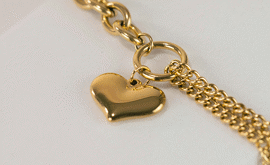How to Spot a Counterfeit Coin
Since the first coin was made almost 3,000 years ago, precious metal coins have held great value in our hearts and pockets. However, this can sadly make them the perfect target for counterfeiters. There is nothing more heart-breaking than knowing your iconic collectors piece holds little to no value, so we’ve pulled together some tips on how you can stay ahead of coin counterfeiters.
What Type of Counterfeit Coins Should I Be Aware of?
There are two types of doctored coins; fake cast coins and struck counterfeit coins. These are made using two different methods which can deceive even the most passionate of coin collectors.
Fake Cast Coins
Fake cast coins often look identical to the real deal. These are coins that have been made from a genuine coin using an exact mould created by pouring a metal mixture directly on the real coin itself. This is a popular method amongst counterfeiters as all this can be done without any damage to the original.
Struck Counterfeit Coins
These coins are arguably the most convincing and unrecognisable of all the fakes in the market as the way in which they are manufactured is very similar to that of authentic coins. This type of coin is produced by a round, flat metal disc, which then creates the coins by being pressed between two moulding plates using a coining press.
How Do I Detect Counterfeit Coins?
If not already apparent from the date and design, there are several ways to verify the authenticity of a gold coin. This includes analysing weights, magneticity, milled edges, the diameter of a coin, micro lettering, and checking for secret images.
Coin Magneticity
Precious metal coins are special. Not only are they special in terms of their beauty but also because of their unique properties, as gold and silver are not magnetic. This provides a fool proof method for counterfeit detection by using one of the most powerful magnetic materials known as neodymium to detect traces of steel, iron and even copper.
The Melt Test
Don’t be alarmed, you won’t need to melt any of your most prized possessions. This involves a simple scientific test for thermal conductivity to determine if you have a fake. This is based on the ability metal has to conduct heat. This is exceptionally high in the case of gold, which has a conductivity of 317 (W/mᐧK), and silver at 419 (W/mᐧK).
To carry out this test all you need is an ice cube which you will place on top of your coin and measure the time it takes for it to melt. This should melt the ice cube faster than metals such as steel, which has a conductivity of 45 (W/mᐧK), and iron, which stands at 71 (W/mᐧK).
Visual Tests
Using coin grading information available, you can draw comparisons for yourself of what you have in your possession, or are viewing, against what a genuine coin should look like. As mentioned earlier, the key features that you can use to verify authenticity are milled edges, micro lettering, secret images and the diameter of a coin’s face. For this you may need a magnifying glass.
We always suggest using instruments that offer the highest accuracy to measure coin features. This is because of the intricacy of coin designs used to deter copying. When measuring diameter, we suggest using callipers as opposed to a ruler which can measure to the hundredths of a millimetre. If not visually noticeable, you can also measure the weight of a coin using a digital weighing scale which will also provide much more accurate results.
Many mints are now designing coins with extra features to help combat counterfeiting. The latest example of this is the Britannia coin. Since 2021, The Royal Mint have added a new laser engraved wave pattern and latent image marker to the coins for added security to the traditional design, as well as a new micro-text feature, making the coin much more difficult to duplicate.
Ping Test
Silver and gold have a certain high-pitched ring to them, and this can be beneficial to investors when identifying genuine coins. Known as the ‘ping test’, this is done by placing one coin on your fingertip and another between your thumb and forefinger and gently tapping your coin. It should produce a high-pitched bell ringing sound as opposed to base metals, whose sounds are much shorter and duller.
XRF Analysers
Here at Atkinsons, we use XRF analysers to ensure our gold and silver coins and bars are genuine. Based on X-ray fluorescence technology, the XRF analyser provides highly reliable results and unlike more traditional testing methods, is completely non-destructive. These devices give an accurate readout of the metal composition, testing the purity and chemistry of all precious metals, ensuring that we confidently deal in genuine gold and silver products only.
What To Do with Counterfeit Coins?
As well as counterfeiting, using a counterfeit coin is an illegal offence and it should be handed in to your local police station. We suggest always purchasing from a trusted and reputable seller to avoid falling victim to this crime.
It is crucial to be aware of the tactics often used by counterfeiters and reassure you that even the most cunning of collectors can be fooled. We hope that these tips shed light on how you can protect yourself against counterfeit fraud.
Why Join Our Mailing List?
By signing up, you'll gain access to exclusive updates, early announcements, and tailored insights into the world of bullion and precious metals.

Latest Updates On Bullion

New Releases

Special Offers

Market Analysis
This blog represents one person’s opinion only. Please note, gold and silver prices may go down as well as up. Atkinsons Bullion & Coins accepts no responsibility for any losses based on information we have provided. We do not offer investment advice. Please carry out your own research before making an investment decision.
















